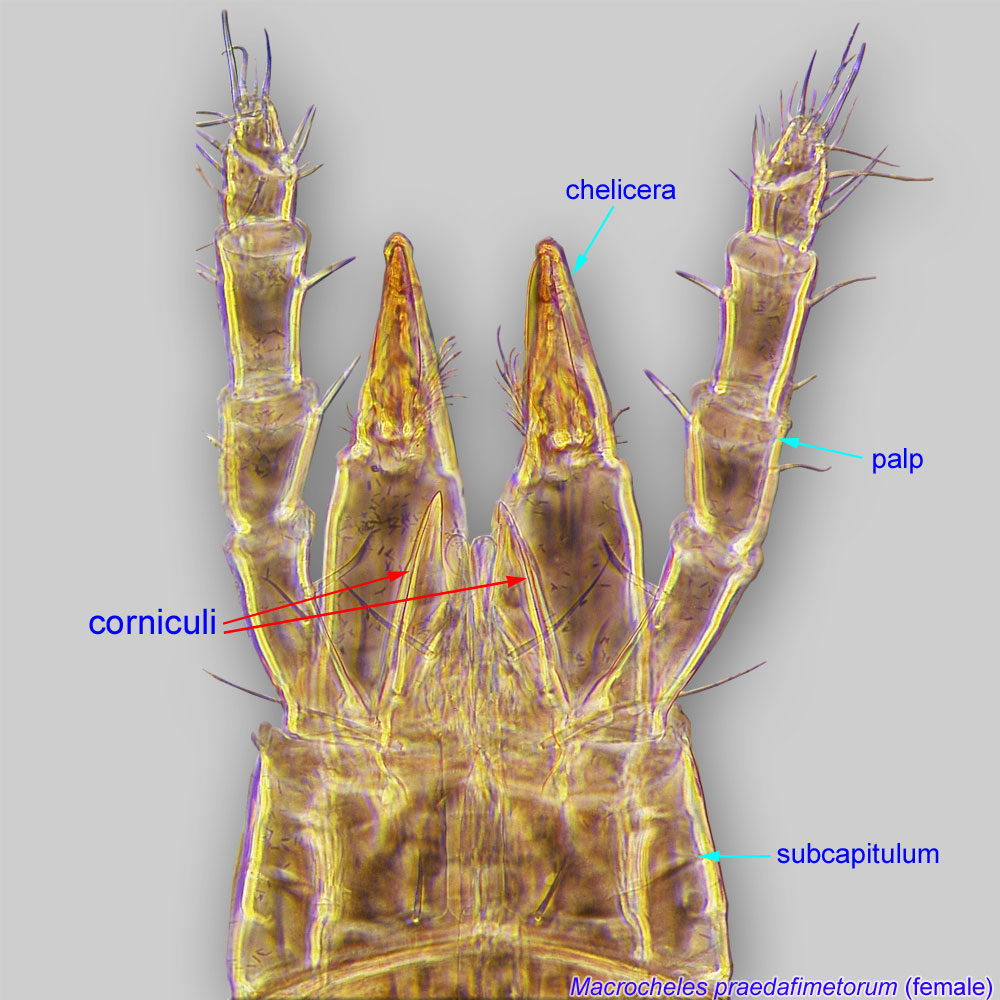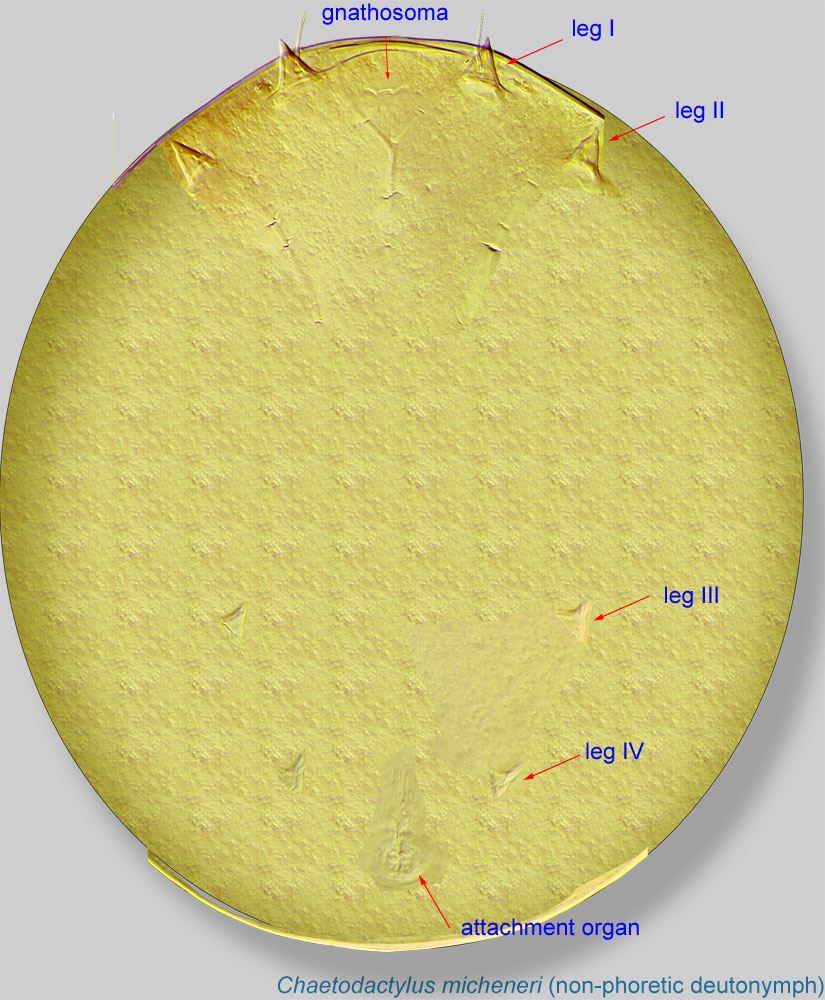generalist species kleptoparasitic; feed on provisioned pollen in honey bee nests and presumably impair bees' flight when on bees in large numbers; species associated with stingless bees (Meliponini) neutral to beneficial; feed on detritus and pollen in nests
Neocypholaelaps Vitzthum, 1942
Superorder Parasitiformes » Order Mesostigmata » Suborder Monogynaspida » Hyporder Dermanyssiae » Family Ameroseiidae » Genus Neocypholaelaps
Laelaps ampullula Berlese, 1910
Female: Dorsal shield not rugose, dorsal setae widened, and dorsal setae j1 widened and pectinate (Fig. 1). CorniculiCorniculus:
Paired, horn-like process (sometimes toothed, bifurcate, trifurcate, spine-like, spatulate, or membranous) on the subcapitulum of parasitiform mites. These processes usually support the salivary styli. If toothed could be confused with a rutellum, a possibly homologous structure in Acariformes and Opilioacarida.
 undivided (Fig. 2). Cheliceral digits edentate or with a single subapical tooth (Fig. 8). All legs with ambulacrumambulacrum:
undivided (Fig. 2). Cheliceral digits edentate or with a single subapical tooth (Fig. 8). All legs with ambulacrumambulacrum:
The claws and empodium of the apotele or pretarsus.
and a pair of claws (Figs. 1, 2, 9, 10). Claws may be well developed (Fig. 10) or weakly developed (Fig. 9).
A dichotomous key is available in Moraes and Narita, 2010Moraes and Narita, 2010:
Moraes, G. J. amp; J. P. Z. Narita. 2010. Description of a new species of Neocypholaelaps (Acari: Ameroseiidae) from Brazil, with a key to the world species. Zootaxa. 2554: 37-44., with updates in Narita et al., 2011Narita et al., 2011:
Narita, J. P. Z., G. J. Moraes amp; L. C. P. Fernando. 2011. Two species of Neocypholaelaps from Sri Lanka (Acari: Ameroseiidae), with description of a new species. Zootaxa. 2741: 59-65. and Narita et al., 2013Narita et al., 2013:
Narita, J. P. Z., M. Pedelabat amp; G. J. De Moraes. 2013. A new species of Neocypholaelaps Vitzthum (Acari: Ameroseiidae), with notes on the cheliceral lobes and ventral pore-like structures of mites of this family. Zootaxa.3661: 1-15..
Neocypholaelaps is distributed in the New and Old Worlds, but mites associated with bees or their nests have been found only in the Old World. This genus commonly occurs in the tropics and subtropics. Neocypholaelaps favus and N. apicola have been found in beehives in temperate regions (Europe and Japan) Haragsim et al., 1987Haragsim et al., 1987:
Haragsim, O., K. Samšiňák amp; E. Vobrázková. 1978. The mites inhabiting the bee hives in ČSR. Zeitschrift für Angewandte Entomologie. 87: 52-67.; Fain and Hosseinian, 2000Fain and Hosseinian, 2000:
Fain, A. amp; S.-H. Hosseinian. 2000. Observations sur des acariens (Acari) infestant les ruches de Apis mellifera race carnica (Insecta Apidae) de Belgique. Bulletin de la Societe Royale Belge d'Entomologie. 136: 32-33.).
honey bees (Apis), carpenter bees (Xylocopa), and other genera of apid bees (Amegilla, Thyreus, and Ctenoplectra) and stingless bees (Heterotrigona, Geniotrigona, Tetragonula, and Meliponula)
Most species are facultativefacultative:
can complete entire life cycle without bees or their close relative, wasps
, while species from stingless bee nests are permanentpermanent:
associated exclusively with bees or their close relative, wasps; cannot live without these hosts
.
most species
species from nests of stingless bees (Neocypholaelaps phooni and N. malayensis)
Pollen and nectar feeders occur on flowers of various plants and use bees and other insects (orders Lepidoptera, Hymenoptera, and Diptera) for dispersal. During a worker honey bee foraging trip, these mites can “hitch-hike” on the bee to be brought back to the colony, where the mites then feed on stored pollen (Delfinado-Baker et al., 1989Delfinado-Baker et al., 1989:
Delfinado-Baker, M., E. W. Baker amp; A. C. G. Phoon. 1989. Mites (Acari) associated with bees (Apidae) in Asia, with description of a new species. American Bee Journal. 129: 609–613.). The number of Neocypholaelaps favus mites in a single colony reached up to 3,000 individuals in Japan (Ishikawa, 1968Ishikawa, 1968:
Ishikawa, K. 1968. Studies on the mesostigmatid mites associated with the insects in Japan. (1). Rep Res Matsuyama Shinonome jr Coll.3: 197-218.). Bees in such hives may become phoreticphoretic:
Pertaining to phoresy; using another organism (i.e., a host) for dispersal to new habitats. Phoresy can be distinguished from parasitism because feeding typically does not occur during phoresy.
hosts to large numbers of mites. Up to 400 N. indica have been recorded on an individual Apis cerana (Ramanan and Swaraj, 1984Ramanan and Swaraj, 1984:
Ramanan, R. V. amp; G. Swaraj. 1984. Observations on the mite Neocypholaelaps indica Evans and its relationship with the honey bee Apis cerana indica Fabricius of Eucalyptus trees. Entomon.9: 291-292.). Bees carrying large numbers of phoreticphoretic:
Pertaining to phoresy; using another organism (i.e., a host) for dispersal to new habitats. Phoresy can be distinguished from parasitism because feeding typically does not occur during phoresy.
mites might exhibit "discomfort" and attempt to remove the mites, and presumably their ability to fly is impaired (Eickwort, 1990Eickwort, 1990:
Eickwort, G. C. 1990. Mites: An Overview. In Honey Bee Pests, Predators and Diseases, 2nd edition, eds. R. Morse amp; R. Nowogrodzki, 188-199. Ithaca: Cornell University Press.).
The lifestyle decribed above is characteristic of mite species normally collected from adult honey bees (Apis), for example, Neocypholaelaps indica. Mite species found on other apid bees (Amegilla, Ctenoplectra, and Xylocopa) probably have a similar biology. Bees of the genus Thyreus that are kletoparasitic on Amegilla serve as phoreticphoretic:
Pertaining to phoresy; using another organism (i.e., a host) for dispersal to new habitats. Phoresy can be distinguished from parasitism because feeding typically does not occur during phoresy.
hosts.
In contrast, some mite species (Neocypholaelaps phooni and N. malayensis) associated with stingless bees (Heterotrigona, Geniotrigona, Tetragonula, and Meliponula) develop more intimate associations with their hosts. The life cycle occurs entirely inside the bee nests, where they consume pollen and detritus, and there is no evidence of parasitism in the brood or on adults (Baker and Delfinado-Baker, 1985Baker and Delfinado-Baker, 1985:
Baker, E. W. amp; M. Delfinado-Baker. 1985. An unusual new species of Neocypholaelaps (Acari: Ameroseiidae) from the nests of stingless bees (Apidae: Meliponinae). International Journal of Acarology;227-232.).
Host plant species have not been extensively studied for Neocypholaelaps, although a few records are available for some mite species. Neocypholaelaps indica, with 34 recorded host plant species (Mo, 1972Mo, 1972:
Mo, C. F. 1972. The male of Neocypholaelaps indica Evans (Acari, Ameroseiidae). Acarologia. 14: 15-17.
Glossary Entry: immobile deutonymphed:
Also known as non-phoretic deutonymph. Applies to Astigmata only. Nymphal stage that serves for survival in severe conditions. Morphology regressive, cyst-like; mouthparts, legs, and attachment organ severely reduced and non-functional.
 ), is the best studied mite in this respect.
), is the best studied mite in this respect.